Научная группа профессора Д.О. Кирсанова
Научная группа кафедры аналитической химии
Лаборатория прикладной хемометрики
Состав группы
 |
Кирсанов Дмитрий Олеговичд.х.н., профессор кафедры аналитической химии
ORCID 0000-0002-5667-6910 ResearcherID J-7508-2012 Scopus ID 6602535169 d.kirsanov@spbu.ru |
 |
Панчук Виталий Владимировичд.ф-м.н, научный сотрудник кафедры аналитической химии, профессор Лаборатории геохимического анализа нефти ORCID 0000-0001-6169-2694 ResearcherIDJ-6050-2013 Scopus 7004659203 v.panchuk@spbu.ru |
 |
Бойченко Екатерина Сергеевнак.т.н., старший научный сотрудниккафедры аналитической химии ORCID 0000-0002-7809-5033 Scopus ID 57194053156 st024697@student.spbu.ru |
Аспиранты и студенты
 |
Деев Владиславаспирант 3 года обучения ORCID 0000-0001-6046-7719 Scopus 57211290237 |
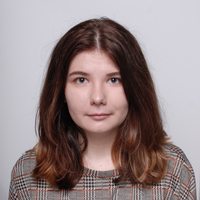 |
Юськина Екатеринааспирант 1 года обучения ORCID 0009-0004-5108-4248 ResearcherID LJM-4527-2024 Scopus 57874141300 st070811@student.spbu.ru |
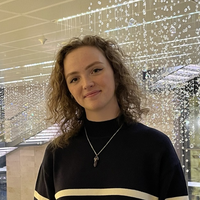 |
Гапонова Аннастудент 4 курса бакалавриата st097838@student.spbu.ru |
 |
Станиславчук-Абовский Дмитрийстудент 4 курса бакалавриата st101520@student.spbu.ru |
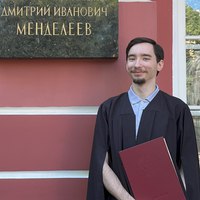 |
Савельев Михаилинженер, студент аспирантуры ORCID 0009-0005-4899-2656 Scopus55674043900 |
 |
Смольянов Николайлаборант-исследователь |
Научная тематика
Основные направления исследований
- Применение методов машинного обучения в химии (хемометрика)
- Обработка результатов спектроскопических, хроматографических и сенсорных измерений
- Электрохимические и оптические мультисенсорные системы
- Решение различных прикладных аналитических задач
Примеры тематики проектов
- Система диагностики рака простаты на основе потенциометрического мультисенсорного анализа
- Мониторинг ключевых компонентов среды переработки облученного ядерного топлива с помощью оптических и электрохимических мультисенсорных систем
- Оценка границ опухолей во время хирургических операций с помощью оптоволоконных оптических зондов в БИК диапазоне
- Он-лайн контроль качества водоочистки на станциях аэрации с набором электрохимических сенсоров
- Изучение аналитических возможностей высокочастотного бесконтактного сенсора на основе катушки индуктивности
Текущие гранты лаборатории
- Грант РНФ № 23-73-01139 «Сочетание методов спектрального анализа и машинного обучения для малоинвазивной диагностики и контроля лечения заболеваний мочеполовой системы»
- Грант РНФ № 23-23-00114 «Исследование аналитических возможностей детектора на основе высокочастотной катушки индуктивности»
- Грант РНФ № 23-23-00108 «Развитие хемометрических подходов в рентгенофлуоресцентном анализе»
Патенты
- Легин А.В., Кирсанов Д.О., Легин Е.А., Бабаин В.А., Аляпышев М.Ю., Елисеев И.И., Борисова Н.Е., Решетова М.Д., Костин А.А. Состав мембраны ионоселективного электрода для определения ионов кадмия. Патент РФ RU 2 428 683 C1 Опубл. 10.09.2011 Бюл. № 25
- Легин А.В., Кирсанов Д.О., Аляпышев М.Ю., Бабаин В.А., Блинова Ю.Н. Состав мембраны ионоселективного электрода. Патент РФ RU 2 460 066 C1 Опубл. 27.08.2012 Бюл. № 24
- Карцова Л. А., Объедкова Е.В., Бессонова Е.А., Кирсанов Д.О., Великанова Л.И. Способ диагностики патологий, связанных с эндокринными заболеваниями. Патент РФ RU2 485 512C2. Опубл. 20.06.2013 Бюл. № 17
Международное сотрудничество
- University of Rome “Tor Vergata” (Italy)
- University of Applied Sciences OWL(Germany)
- University of Aveiro (Portugal)
- University Lille 1 (France)
- Hangzhou University (China)
- Jadavpur University (India)
- Art photonics GMbH (Germany)
- Catholic University of Leuven (Belgium)
Публикации
Избранные публикации за последние три года
Math is greener than chemistry: Assessing green chemistry impact of chemometrics
Q1Mikhail Saveliev, Vitaly Panchuk, Dmitry Kirsanov
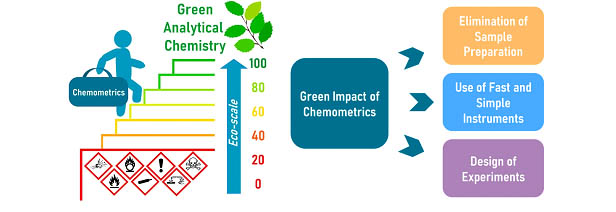
Chemometric modeling is an important part of the modern analytical chemistry allowing reliable qualitative and quantitative analysis in numerous practically important tasks. Besides significant simplification and cost reduction of analytical procedures achieved through the application of chemometrics, there is a considerable green impact from the use of these methods. However, not so many reports evaluate the particular impact of the chemometric procedures on making the analysis green. Here we evaluate this impact using the popular Eco-Scale greenness score. A combination of chemometric methods with inexpensive spectroscopic, electroanalytical and other techniques eliminates the need in applying dangerous and environmentally unfriendly reagents and procedures. Based on the literature data from several representative case studies we have demonstrated that the EcoScale score in addressing particular analytical tasks can be improved up to 40 points through the use of chemometric-based methods.
TrAC - Trends in Analytical Chemistry.2024, 172, paper#117556doi.org/ 10.1016/j.trac.2024.117556
Quantification of elements in spent nuclear fuel using intrinsic radioactivity for sample excitation and chemometric data processing
Q1Vitaly Panchuk, Yuriy Petrov, Valentin Semenov, Dmitry Kirsanov
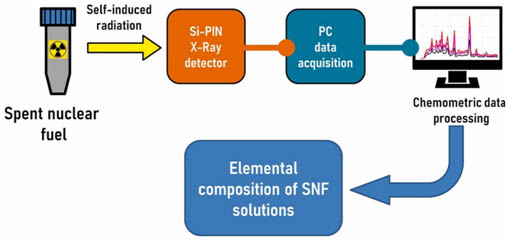
Quantitative analysis of spent nuclear fuel (SNF) is a very challenging task. High radioactivity, complex chemical composition and personnel safety requirements severely limit the number of analytical tools suitable for this problem. There is an urgent need for the methods that would provide for remote on-line quantification of elements in spent nuclear fuel and its reprocessing technological solutions. Here we propose a novel approach based on the registration of X-ray fluorescence radiation from SNF samples induced by fission products radioactivity. In this case the X-ray excitation conditions will obviously vary from sample to sample; moreover the resulting spectra will be a complex superposition of numerous signals from soft gamma emitters and X-ray fluorescence of various nature. These complex spectra can be effectively treated with chemometric data processing for quantification of particular elements. We have demonstrated the validity of this approach for direct analysis of U, Zr and Mo in SNF raffinate.
Analytica Chimica Acta. 2023, 1239, paper# 340694.doi.org/10.1016/j.aca.2022.340694
Validation of classification models in cancer studies using simulated spectral data – A “sandbox” concept
Q2 Ekaterina Boichenko, Andrey Panchenko, Margarita Tyndyk, Mikhail Maydin, Stepan Kruglov, Viacheslav Artyushenko, Dmitry Kirsanov
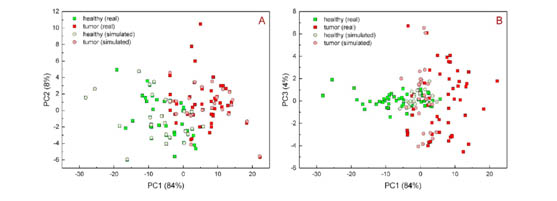
Spectroscopy has become a popular method in research devoted to cancer diagnostics, therapy, and surgery –anywhere we need to detect tumor cells surrounded by non-cancerous ones. Usually, chemometrics methods are applied to classify cancerous and non-cancerous sites, so proper validation of classification models is required to ensure the reliability of the obtained results. In this study, we suggest using real data for simulation of spectral sets with varying characteristics (size, distribution of classes) – an analog of “sandbox” used in software development – and to validate the models in different conditions. Near-infrared spectra (939–1796 nm) measured from breast tumors and healthy tissues of laboratory mice (152 spectra) were used for simulation of spectral data sets of different sizes (50, 100, 150 spectra). We proposed a simple simulation method based on a singular value decomposition of the real spectral dataset and rearrangement of the calculated residuals. Several algorithms of training and test set selection have been applied to the simulated data (Kennard-Stone, DUPLEX, random, Monte-Carlo cross-validation), and corresponding Support Vector Machines classification models have been trained, optimized, and validated by using a series of test sets with varying “healthy: tumor” classes distribution (1:1,3:1,1:3) and size (10%, 30%, and 50% of the training data set). Performance of the classification models, expressed in values of accuracy, sensitivity, and selectivity, has been compared, and a validation strategy has been proposed.
Chemometrics and Intelligent Laboratory Systems.2022, 225, 104564 doi.org/10.1016/j.chemolab.2022.104564
A Simple Contactless High-Frequency Electromagnetic Sensor: Proof of Concept
Q1Ekaterina Yuskina, Nikodim Makarov, Maria Khaydukova, Tatiana Filatenkova, Olga Shamova, Valentin Semenov, Vitaly Panchuk, Dmitry Kirsanov

We report on the development of a very simple and inexpensive sensor device based on an inductance coil connected to a high-frequency electric field generator. The working principle of this sensor is as follows: liquid sample in a plastic tube is placed inside the inductance coil as its core and this core changes the properties of high-frequency electric current passing through the coil; these changes depend on sample conductivity, dielectric constant, magnetic properties, and capacitance. The electric signal registered after the coil represents a kind of a spectrum that can be effectively treated with chemometric tools. Our studies have shown that such a sensor can be used to distinguish between substances with different physical and chemical properties; different concentrations of ions in aqueous solutions with a linear response in a broad concentration range from 10–3 M to 10–1 M; can quantify the fat content in milk and cream samples with about 2% accuracy; and can distinguish between bacterial cultures and cell line cultures. The measurements are very fast and contactless, and the results show good promise for developing a number of applications of this sensor system.
Anal. Chem. 2022, 94, 35, 11978–11982doi.org/10.1021/acs.analchem.2c02067
2024 год
- Saveliev, M., Panchuk, V., Kirsanov, D. Math is greener than chemistry: Assessing green chemistry impact of chemometrics (2024) TrAC - Trends in Analytical Chemistry, 172, paper#117556. DOI: 10.1016/j.trac.2024.117556
- Deev V., Panchuk V., Boichenko E., &Kirsanov D. (2024). Spectrum is a picture: Feasibility study of two-dimensional convolutional neural networks in spectral processing. Microchemical Journal, 205, 111329.DOI: 10.1016/j.microc.2024.111329
- Semenov, V., Grigoriev, M., Kirsanov, D., Panchuk, V. When one equals two: Chemometrics turns Mössbauer spectrometer into X-ray fluorescence one (2024) Spectrochimica Acta - Part B Atomic Spectroscopy, 213, paper#106878. DOI: 10.1016/j.sab.2024.106878
- Iurgenson, N., Wang, X., Kong, L., Sun, X., Legin, A., Wang, P., Wan, H., Kirsanov, D. Feasibility study of multisensor systems for the assessment of water pollution index induced by heavy metal contamination (2024) Microchemical Journal, 197, paper#109762. DOI: 10.1016/j.microc.2023.109762
- Selivanovs, Z., Savosina, J., Agafonova-Moroz, M., Kirsanov, D. Nonlinear dimensionality reduction methods for potentiometric multisensor systems data analysis (2024) Electroanalysis, 36 (1), paper# e202300220. DOI: 10.1002/elan.202300220
- Yuskina, E.,Boichenko, E., Makarov, N., Panchuk, V., Kirsanov, D. Inductance coil high-frequency contactless chemical sensor: Systematic study of its cationic sensitivity (2024) Measurement,232, paper#114716. DOI: 10.1016/j.measurement.2024.114716
- Yuskina, E., Panchuk,V., Kirsanov, D.O.Evolution of Contactless Conductometry Methods (2024) Journal of Analytical Chemistry, 79(6), 654–662. DOI: 10.1134/S1061934824700023
- Meshina, K., Tkachenko, D., Kochnev, N., Lunkov, S., Panchuk, V., Kirsanov, Bobrysheva, N., Osmolowsky, M., Voznesenskiy, M., Osmolovskaya O.Understanding the role of ZnO nanosheet surface in photocatalytic dye degradation: The key to effective wastewater treatment (2024) Ceramics International, 50 (19), 35103-35114. DOI:10.1016/j.ceramint.2024.06.317
- Vladimirova, N., Bochko, T., Shishov, A.,Kirsanov, D. Predicting the properties of deep eutectic solvents based on choline chloride and carboxylic acids and their mixtures with water using QSPR approach (2024) Colloids and Surfaces A: Physicochemical and Engineering Aspects, 692, paper#133961. DOI: 10.1016/j.colsurfa.2024.133961
- Rashitova, K., Kirsanov, D., Voznesenskiy, M., Osmolovskaya, O. PVC plasticized membranes modified with Fe3O4 nanoparticles for potentiometric sensing of sulfate (2024) Surfaces and Interfaces, 48, paper#104326. DOI: 10.1016/j.surfin.2024.104326
- Braunger, M.L., Neto, M.P., Kirsanov, D., Fier, I., Amaral, L.R., Shimizu, F.M., Correa, D.S., Paulovich, F.V., Legin, A., Oliveira, O.N., Riul, A.Analysis of Macronutrients in Soil Using Impedimetric Multisensor Arrays (2024) ACS Omega,9(31),33949–33958. DOI: 10.1021/acsomega.4c04452
2023 год
- Boichenko, E., Kirsanov, D. Optical spectroscopy and chemometrics in intraoperative tumor margin assessment (2023) TrAC - Trends in Analytical Chemistry, 160, paper#116955. DOI: 10.1016/j.trac.2023.116955
- Boichenko, E., Paronnikov, M., Kirsanov, D. (2023) Pilot Study on the Qualitative Analysis of Urinary Stones Using Near-Infrared Spectroscopy and Chemometrics. Eng. Proc., 48, 64. DOI: 10.3390/CSAC2023-15162
- Surkova, A., Bogomolov, A., Paderina, A., Khistiaeva, V., Boichenko, E., Grachova, E., Kirsanov, D. (2023) Milk Analysis using a New Optical Multisensor System Based on Lanthanide(III) Complexes. Eng. Proc., 48, 28. DOI: 10.3390/CSAC2023-14923
- Yuskina, E., Makarov, N.,Khaydukova, M., Semenov, V.,Panchuk, V.,Kirsanov, D. Sensor Device for Contactless Chemical Analysis Based on High-Frequency Inductance Coil (2023) Eng. Proc., 48, 42. DOI: 10.3390/CSAC2023-14886
- Belugina, R., Puchkova, E., Yuskina, E., Khalatov, A., Podberezskiy, V., Savinov, S., Legin, A., Panchuk, V., Kirsanov, D. Getting rid of reference electrode in potentiometric multisensor measurements (2023) Sensors and Actuators B: Chemical, 393, paper# 134269. DOI: 10.1016/j.snb.2023.134269
- Konopkina, E.A., Pozdeev, A.S., Kalle, P., Kirsanov, D.O., Smol'yanov, N.A., Kirsanova, A.A., Kalmykov, S.N., Petrov, V.G., Borisova, N.E., Matveev, P.I. Sensing and extraction of hazardous metals by di-phosphonates of heterocycles: a combined experimental and theoretical study (2023) Dalton Transactions, 52 (36), pp. 12934-12947. DOI: 10.1039/d3dt01534c
- Selivanovs, Z., Panchuk, V., Kirsanov, D. On the Possibility of Universal Chemometric Calibration in X-ray Fluorescence Spectrometry: Case Study with Ore and Steel Samples (2023) Applied Sciences (Switzerland), 13 (9), paper#5415. DOI: 10.3390/app13095415
- Kochnev, N.D., Tkachenko, D.S., Kirsanov, D.O., Bobrysheva, N.P., Osmolowsky, M.G., Voznesenskiy, M.A., Osmolovskaya, O.M. Regulation and prediction of defect-related properties in ZnO nanosheets: synthesis, morphological and structural parameters, DFT study and QSPR modeling (2023) Applied Surface Science, 621, paper#156828. DOI: 10.1016/j.apsusc.2023.156828
- Maltsev, A.S., Umarova, N.N., Pashkova, G.V., Mukhamedova, M.M., Shergin, D.L., Panchuk, V.V., Kirsanov, D.O., Demonterova, E.I. Combination of Total-Reflection X-Ray Fluorescence Method and Chemometric Techniques for Provenance Study of Archaeological Ceramics (2023) Molecules, 28 (3), paper# 1099. DOI: 10.3390/molecules28031099
- Savosina, J., Agafonova-Moroz, Naumov, A., Nikolaev, A., Lumpov, A., M., Babain, V., Legin, A., Olivieri, A., Parastar, H., Kirsanov, D. Simultaneous Quantification of Zr, Mo, U, Np and Pu in Technological Solutions of Spent Nuclear Fuel Reprocessing with a Potentiometric Multisensor System (2023) Sensors and Actuators: B. Chemical, DOI: 10.1016/j.snb.2023.133315
- Panchuk, V., Petrov, Y., Semenov, V., Kirsanov, D. Quantification of elements in spent nuclear fuel using intrinsic radioactivity for sample excitation and chemometric data processing (2023) Analytica Chimica Acta, 1239, paper# 340694. DOI: 10.1016/j.aca.2022.340694
2022 год
- Boichenko, E., Panchenko, A., Tyndyk, M., Maydin, M., Kruglov, S., Artyushenko, V., &Kirsanov, D. (2022). Validation of classification models in cancer studies using simulated spectral data–A “sandbox” concept. Chemometrics and Intelligent Laboratory Systems, 225, 104564. DOI: 10.1016/j.chemolab.2022.104564
- Pashkova, G.V., Zhilicheva, A.N., Chubarov, V.M., Maltsev, A.S., Ukhova, N.N., Pellinen, V.A., Sokolnikova, J.V., Kirsanov, D.O., Panchuk, V.V., Marfin, A.E. Improvement of suspension-assisted total reflection X-ray fluorescence analysis of ores using wet grinding and empirical calibrations (2022) Spectrochimica Acta - Part B Atomic Spectroscopy, 198, paper#106549. DOI: 10.1016/j.sab.2022.106549
- Vladimirova, N., Puchkova, E., Dar’in, D., Turanov, A., Babain, V., Kirsanov, D. Predicting the Potentiometric Sensitivity of Membrane Sensors Based on Modified Diphenylphosphoryl Acetamide Ionophores with QSPR Modeling (2022) Membranes, 12 (10), paper# 953. DOI: 10.3390/membranes12100953
- Dehabadi, M., Yemisci, E., Kursunlu, A.N., Kirsanov, D. Novel Pillar[5]arenes Show High Cross-Sensitivity in PVC-Plasticized Membrane Potentiometric Sensors (2022) Chemosensors, 10 (10), paper# 420. DOI: 10.3390/chemosensors10100420
- Alyapyshev, M., Babain, V., Kirsanov, D. Isolation and Purification of Actinides Using N,O-Hybrid Donor Ligands for Closing the Nuclear Fuel Cycle (2022) Energies, 15 (19), paper# 7380. DOI: 10.3390/en15197380
- Yuskina, E., Makarov, N., Khaydukova, M., Filatenkova, T., Shamova, O., Semenov, V., Panchuk, V., Kirsanov, D. A Simple Contactless High-Frequency Electromagnetic Sensor: Proof of Concept (2022) Analytical Chemistry, 94 (35), pp. 11978-11982. DOI: 10.1021/acs.analchem.2c02067
- Wang, X., Lin, W., Chen, C., Kong, L., Huang, Z., Kirsanov, D., Legin, A., Wan, H., Wang, P. Neural networks based fluorescence and electrochemistry dual-modal sensor for sensitive and precise detection of cadmium and lead simultaneously (2022) Sensors and Actuators B: Chemical, 366, paper# 131922. DOI: 10.1016/j.snb.2022.131922
- Belugina, R., Senchikhina, A., Volkov, S., Fedorov, A., Legin, A., Kirsanov, D. Quantification of phosphatides in sunflower oils using a potentiometric e-tongue (2022) Analytical Methods, 14 (32), pp. 3064-3070. DOI: 10.1039/d2ay00736c
- Surkova, A., Bogomolov, A., Paderina, A., Khistiaeva, V., Boichenko, E., Grachova, E., Kirsanov, D. Optical Multisensor System Based on Lanthanide(III) Complexes as Near-Infrared Light Sources for Analysis of Milk (2022) Chemosensors, 10 (7), paper# 288. DOI: 10.3390/chemosensors10070288
- Aidene, S., Khaydukova, M., Savinov, S., Semenov, V., Kirsanov, D., Panchuk, V. Partial least squares assisted influence coefficients concept improves accuracy in X-ray fluorescence analysis (2022) Spectrochimica Acta - Part B Atomic Spectroscopy, 193, paper# 106452. DOI: 10.1016/j.sab.2022.106452
- Dehabadi, M., Saveliev, M., Legin, A., Yaghmaei, S., Babain, V., Kirsanov, D. Using commercial calcium ionophores to make lanthanide sensors (2022) Journal of Radioanalytical and Nuclear Chemistry, 331 (4), pp. 1751-1758. DOI: 10.1007/s10967-022-08220-5
- Jendrlin, M., Radu, A., Zholobenko, V., Kirsanov, D. Performance modelling of zeolite-based potentiometric sensors (2022) Sensors and Actuators B: Chemical, 356, paper# 131343. DOI: 10.1016/j.snb.2021.131343
- Kravić, N., Savosina, J., Agafonova-Moroz, M., Babain, V., Legin, A., Kirsanov, D. Nonlinear Multivariate Regression Algorithms for Improving Precision of Multisensor Potentiometry in Analysis of Spent Nuclear Fuel Reprocessing Solutions (2022) Chemosensors, 10 (3), paper# 90. DOI: 10.3390/chemosensors10030090
- Wang, X., Kong, L., Zhou, S., Ma, C., Lin, W., Sun, X., Kirsanov, D., Legin, A., Wan, H., Wang, P. Development of QDs-based nanosensors for heavy metal detection: A review on transducer principles and in-situ detection (2022) Talanta, 239, paper# 122903. DOI: 10.1016/j.talanta.2021.122903
- Vladimirova, N., Polukeev, V., Ashina, J., Babain, V., Legin, A., Kirsanov, D. Prediction of Carbonate Selectivity of PVC-Plasticized Sensor Membranes with Newly Synthesized Ionophores through QSPR Modeling (2022) Chemosensors, 10 (2), paper# 43. DOI: 10.3390/chemosensors10020043
- Shariat, K., Kirsanov, D., Olivieri, A.C., Parastar, H. Sensitivity and generalized analytical sensitivity expressions for quantitative analysis using convolutional neural networks (2022) Analytica Chimica Acta, 1192, paper#338697. DOI: 10.1016/j.aca.2021.338697
- Ren, Y., Polukeev, V.A., Kenf, E.V., Tkachenko, L.I., Alyapyshev, M.Y., Babain, V.A., Nechaev, A.V., Legin, A.V., Kirsanov, D.O. Substituted diamides of dipicolinic acid as extractants and ionophores for rare earth metals (2022) Journal of Rare Earths. DOI: 10.1016/j.jre.2022.08.003
Информация для студентов
Мы приглашаем в лабораторию студентов бакалавриата и магистратуры для выполнения выпускных квалификационных работ и работ по грантам. Тематика работ определяется текущими проектами группы, есть возможность выбора между расчётной работой и экспериментальной.


